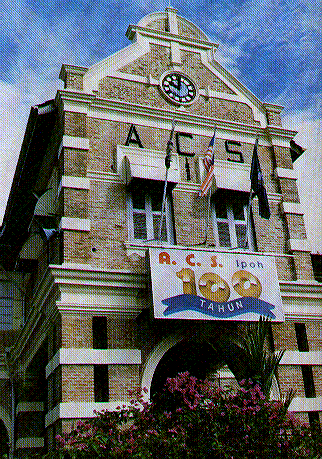

Back to the main page
 Ten years after the founding of the Methodist Mission in Singapore, there in Ipoh on 31st July 1895, a young Englishman, the Rev. E. Horley, who was destined to play a vital rope in the enhancement of the education and spiritual life of youth in this country.
Ten years after the founding of the Methodist Mission in Singapore, there in Ipoh on 31st July 1895, a young Englishman, the Rev. E. Horley, who was destined to play a vital rope in the enhancement of the education and spiritual life of youth in this country.A few days after his arrival, on 5th August, Mr. Horley opened the Anglo-Chinese School in a small attap-roofed Malay house adjoining the Police barracks behind the old Land Office which was later demolished to make way for a new million-dollar mosque. Ipoh at that time was no more than a small mining village.
The school was a resuscitation of the first English school in Kinta opened by the Rev. T. W. Stagg in January that year and closed soon after because of his departure fron Ipoh in June 1895 on account of his wife`s health.
The house in which Mr. Horley established the school was rented from the then Dato Panglima Kinta, Yusuf bin Nasam, and Sir George Maxwell, who in one of his letters described it as being "painted a rich blue with yellow shuttlers". This is probably the reason why blue and gold were chosen as the School`s colours in the mid-nineteen twenties. Mr. Stagg, became Mr. Horley`s first assistant teacher and local preacher.
The history of the A.C S. is very closely linked with the history and developement of Ipoh which has been described as "the town that tin built". It is perhaps fitting to note that the school was founded just three years after "the great fire of Ipoh in June, 1892 which burned down over half the village, destroying 123 houses". By the time Mr. Horley arrived, Ipoh had become a town, the Ipoh Sanitary Board having been established in 1893. "From the very beginning I found the Perak Goverment sympathetic and willing to help. I applied for four acres of land for a Church and school and this was given to me on the Lahat Road," according to Mr. Horley as recorded in his Diary.
"I immediately had the jungle and blukar cut down. The swamps were filled in and the ground levelled, and in November, 1895, I commenced building a school-church."
It is interesting to note that just before these two buildings were completed Bishop James M. Thoburn, who was responsible for osting Mr. Horley from Singapore to Ipoh, himself arrived on a visit to Ipoh on 11th February, 1896. He was accompanied by Messrs. West, Pykett and Curtis and had travelled from Penang to Telok Anson(now Teluk Intan) by a small coasting streamer, the Lady Weld. The train journey from Telok Anson to Ipoh took three-and-a-half hours.
Bishop Thorburn said of his arrival in Ipoh:"As the train began to slow down, Mr. West called me to his window and pointed out a new brick building just nearing completion and said, `There is the the new Methodist Church'. I was quite surprised to see tasteful building 72 feet by 30 feet and asked the cost was expected to be. `About $3,000' was the reply. Noticing another building going up nearby, I asked what it was, and was still more surprised when told it was the mission house. It is to be a comfortable building, and is expected to be ready for occupancy in three months. Truly our young missionary Brother Horley is putting energy into his new work. I was very sorry that this vigorous worker was not at home during our visit."
In his speech at the 65th Anniversary Celebrations in 1960, the then Principal Mr. Teerath Ram said the years 1895 and 1896 were not only most important ones in the history of the A.C.S. Ipoh, but they were important ones for other reasons as well.
"It was in 1895 that the Treaty of Federation was signed uniting Perak, Selangor, Pahang and Negeri Sembilan into the Federated Malay States, duly inaugurated on 1st July, 1896. It was also in 1896 that the first pessenger train from Perak to Kuala Lumpur conveyed His Highness the Sultan of Perak to attend the Conference of Chiefs of the Federated Malay States."
The Church, incidentally, is the oldest Methodist building on the Federation of Malaya mainland; and it is of the same age as Bishop Amstutz, who in his younger days served in Ipoh as Pastor and teacher in 1933.
It is also an inescapable fact of history that the Girls' School, which was also founded by Mr. Horley, a few weeks after he had started the Boys' School, remained an integral part of the A.C.S. until the Woman's Foreign Missionary Society, after much persuasion and hesitation finally took it over from Mr. Horley.
Even in those slow-moving and leisurely days when it took eight hours to get to Taiping in a "shandrydan" (a light cart on springs), buildings could not keep pace with the growing enrolments of the A.C.S. Ipoh.


Back to the main page